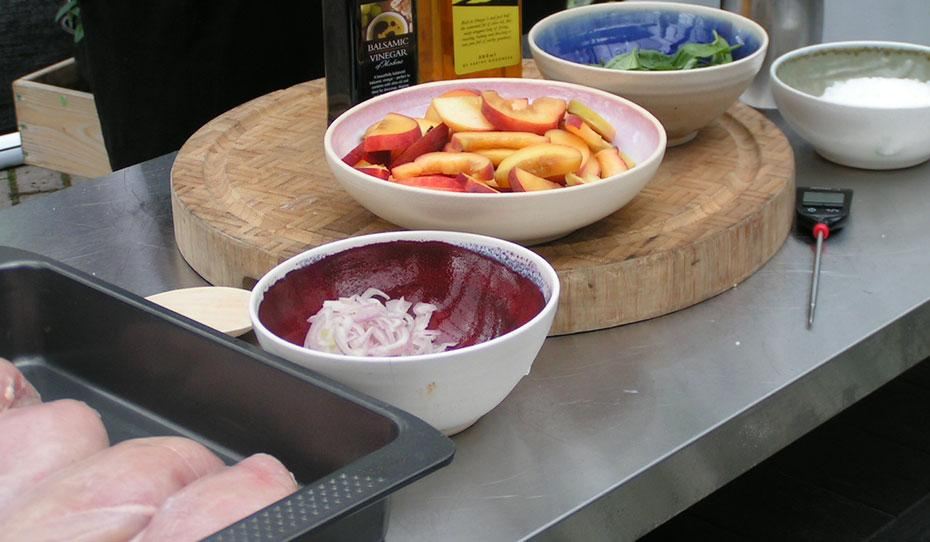Stay healthy and enjoy delicious food and great company
Chicken with balsamic peaches (pictured above)
There’s nothing like having a barbecue for family and friends when the weather is gorgeous; great company and delicious food is always a winner, especially when the sun’s shining. Food poisoning is a very real threat if certain hygiene precautions are not observed but the chances of becoming ill can be completely eliminated by taking a few simple common sense measures. Food poisoning can vary from a mild tummy upset to being fatal so it cannot be stated too strongly the importance of observing good hygiene and proper food handling practices.
The government Food Standards Agency class the risks as the 4c’s: chilling, cooking, cleaning and cross-contamination. If you just keep these in mind when prepping your ingredients and grilling then your party will go off without anyone being ill. Make sure you have hand sanitiser, probe wipes, anti-bactericidal spray and disposable cloths on hand also somewhere to rinse out the cloths between use. Always start by washing your hands thoroughly in soap and water.
Chilling
- If grilling frozen meat always de-frost overnight in the fridge, never leave out at room temperature. Some sources state that it is acceptable to de-frost in the microwave just prior to grilling but we don’t recommend this as the centre can be still frozen when the outside is starting to become warm. This can lead to the food grilling unevenly with the outside charring before the inside is cooked.
- Leave cooked food to cool before placing in the fridge; placing warm food into the fridge raises the temperature to an unsafe level. Leave out for no more than 1 – 2 hours until cooled.
- Room temperature meat cooks quicker and more evenly than that cooked from chilled but take out of the fridge no more than 30 minutes before grilling.
- Position your prep table in the shade and not in direct sun as this can raise the temperature to an unsafe level.
Cooking
- Make sure your food is cooked in the centre by using a digital temperature probe; stabbing it with a knife lets the juices escape and leads to dry meat; for the sake of a few pounds a probe is an essential piece of kit.

- Always wipe the probe between uses, especially if checking different meats such as chicken and beef. Use a food safe bactericidal wipe.
- Learn what the safe cooked temperatures are for the various meats (see the bottom of this blog). Grilling to the safe temperatures ensures that any bacteria present is killed.
- When probing meat or fish make sure you insert the probe into the thickest part and don’t go all the way through towards the heat source. There is a school of thought that you pre-cook in the oven and then finish off on the grill but this is fraught with danger as the meat could be left at an unsafe temperature between coming out of the oven and being cooked on the grill. Chicken and seafood can be safely cooked from start to finish on the barbecue; just probe and take off when the safe temperature is reached. For chicken, sausages and burgers remember the slogan “75C staying alive”.
- Charred on the outside doesn’t mean cooked on the inside; check the temperature.
- Learn to use your barbecue and the different methods of grilling; direct and indirect. This ensures that you don’t always cook over high heat but also cook over the indirect heat to cook the meat through. Check out our Events page for details of the barbecue courses we regularly hold here in store; instructors include top BBQ chefs Richard Holden and Andrew Dickens and trained Weber and Traeger grillmasters.
- Always serve beef burgers well done unless you are making them fresh yourself from high welfare local meat from a reputable source, which is usually your local butcher.
- Keep desserts in the fridge until they are ready to be served.
- If serving food over several hours just put out salads and dips in small batches to avoid them becoming too warm.
Cleaning
- Always use a prep table with a wipe clean surface, not porous wood. If you only have a wooden trestle table cover with a plastic cloth.
- Keep washing your hands throughout the cook.
- Clean the grill thoroughly before use and make sure the barbecue is hot and has reached temperature before placing meat on the grate.
- Don’t touch your face then the food without using a bactericidal hand wipe.

Image: Porchetta cooked on the Traeger wood pellet grill
Cross-contamination
- Use two sets of tools; one for raw food and the other for cooked food. Keep them hanging on separate sides of the barbecue to avoid cross contamination.
- Never wash raw chicken; this can spread any bacteria present.
- Keep the different raw meats on separate plates.
- Use different chopping boards for cooked and raw food and wipe down with anti-bactericidal spray between each use.
- Wash hands after touching raw meat.
- Don’t re-use a marinade as a dipping sauce or dressing as it may have been contaminated with bacteria.

Image: spatchcock chicken cooked on the Weber grill
Safe internal temperatures of cooked food:
- Poultry (chicken, turkey, duck) - 74C/165F
- Sausages and burgers - 71C/160F
- Beef lamb and veal - rare 43 – 49C/110 – 120F
medium 57 – 63C/135 – 145F
well done 68C+/155F+
- Pork roasts, steaks and chops - medium 63C/145F
- Fish - 63C/145F
- Pork ribs and shoulder, beef ribs and brisket - 88C – 96C/190 – 205F
- Pulled pork and beef - 96C/205F


